Cork Oak Regeneration Prediction Through Multilayer Perceptron Architectures
Abstract
1. Introduction
2. Materials and Methods
2.1. Study Area and Experimental Design
2.2. Regeneration and Tree Samplings
2.3. Multilayer Perceptron Analysis
2.4. Performance Analysis of MLP Models
2.5. Comparison Between MLP Models and Other Prediction Statistical Models
2.6. Assessing the Effects of Inputs on Outputs
3. Results
3.1. Performance Analysis of the MLP Models
3.2. Comparison of the Best MLPs with Other AI and Non-AI Models
3.2.1. Comparison Between MLP Models and Other Dedicated AI Models
3.2.2. Comparison Between MLP Models and Non-AI Models
3.3. Main Effect of the Input Factors
4. Discussion
4.1. The Relative Importance of Main Explicative Factors on Seedling Regeneration
4.2. The Ability of MLP to Prediction of Seedling Regeneration Compared with Other Models
5. Conclusions
Author Contributions
Funding
Data Availability Statement
Acknowledgments
Conflicts of Interest
Abbreviations
| AI | Artificial intelligence |
| AICc | Corrected Akaike information criterion |
| AUC | Area under curve |
| BIC | Bayesian information criterion |
| BT | Bootstrap forest |
| C0 | Classes with no acorns or seedlings |
| C1 | Classes with quantity of acorns and seedlings between one to four |
| C2 | Classes with a quantity of acorns and seedlings above four |
| CFA | Confirmatory Factor Analysis |
| CFI | Comparative Fit Index |
| DOY | Day of year |
| DT | Decision tree |
| EFA | Exploratory Factor Analysis |
| ER2 | Entropy R-square |
| GAUS | Gaussian activation function |
| GR2 | Generalized R-square |
| GRB | Generalized regressions with Bridge |
| GRE | Generalized regressions with Elastic Net |
| GRL | Generalized regressions with Lasso |
| H | Height |
| H1 | Hidden layer link with output variable |
| H2 | Hidden layer ling with input variable |
| IRI | Independent resampled input |
| kNN | k-nearest neighbor |
| LIN | Linear activation function |
| MAD | Mean absolute deviation |
| MLP | Multilayer perceptron |
| MR | Misclassification rate |
| NB | Naive Bayes |
| NFI | Normed Fit Index |
| NL | Nominal logistic |
| NLL | Negative log-likelihood |
| NN | Neural network |
| NNB | Neural network boosted |
| PDS | Presence of dead seedling |
| PR | Precision-recall |
| PRAUC | Area under curve of precision-recall |
| Q1 | First quadrant |
| Q2 | Second quadrant |
| Q3 | Third quadrant |
| Q4 | Fourth quadrant |
| RASE | Root average squared error |
| RMSEA | Root Mean Square Error of Approximation |
| RND | Random normal distribution |
| ROC | Receiver operating characteristic |
| ROCAUC | Area Under Curve of Receiver Operating Characteristic |
| SDI | Stand density index |
| SRMR | Standardized Root Mean Square Residual |
| SVM | Support vector machine |
| TanH | Hyperbolic tangent activation function |
| TLI | Tucker-Lewis Index |
| TPH | Tree per hectare |
| TS1 | Total seedling (Living) with height ≤ 10 cm |
| TS2 | Total seedling (Living) with height > 10 cm |
Appendix A
| Layer | Variables | Classes | Details | Percentages (%) | ||
|---|---|---|---|---|---|---|
| Total | Plot A1 | Plot A2 | ||||
| Input | Acorn | C0 | Absence of acorns | 35.64 | 41.67 | 29.69 |
| C1 | Presence between 1 and 4 acorns per m2 | 30.94 | 26.04 | 35.42 | ||
| C2 | Presence of more than 4 acorns per m2 | 33.43 | 32.29 | 34.90 | ||
| PDS | No | Absence of dead seedling | 90.88 | 89.58 | 89.58 | |
| Yes | Presence of dead seedling (max 4) | 9.12 | 10.42 | 10.42 | ||
| Slope | No | Flat terrain (<±5° or ~8.75%) | 37.29 | 37.50 | 37.50 | |
| Yes | Sloping terrain measured between 5° and 20° (36.4%) | 62.71 | 62.50 | 62.50 | ||
| Output | TS1 | C0 | Absence of seedling H ≤ 10 per m2 | 39.78 | 37.50 | 43.23 |
| C1 | Presence between 1 and 4 seedling H ≤ 10 per m2 | 39.78 | 42.19 | 36.46 | ||
| C2 | Presence of more than 4 seedling H ≤ 10 per m2 | 20.44 | 20.31 | 20.31 | ||
| TS2 | C0 | Absence of seedling with H > 10 per m2 | 37.85 | 20.31 | 56.77 | |
| C1 | Presence between 1 and 4 seedlings with H > 10 per m2 | 48.07 | 56.25 | 38.54 | ||
| C2 | Presence of more than 4 seedlings with H > 10 per m2 | 14.09 | 23.44 | 4.69 | ||
| Dataset | Variables | Statistics | |||||
|---|---|---|---|---|---|---|---|
| Mean | SD | SE | U 95% | L 95% | |||
| Total | RND | 0.00 | 0.99 | 0.11 | 0.24 | −0.24 | |
| Components of RND | Acorns | 8.00 | 4.90 | 0.61 | 9.22 | 6.78 | |
| TS1 | 20.47 | 20.17 | 2.52 | 25.51 | 15.43 | ||
| TS2 | 20.47 | 20.17 | 2.52 | 25.51 | 15.43 | ||
| Dead seedling | 1.75 | 2.48 | 0.31 | 2.37 | 1.13 | ||
| Plot A1 | RND | −0.01 | 0.93 | 0.16 | 0.32 | −0.35 | |
| Components of RND | Acorns | 7.25 | 4.17 | 0.74 | 8.75 | 5.75 | |
| TS1 | 20.61 | 19.5 | 3.45 | 27.64 | 13.58 | ||
| TS2 | 26.46 | 18.02 | 3.19 | 32.95 | 19.96 | ||
| Dead seedling | 1.27 | 2.72 | 0.48 | 2.25 | 0.29 | ||
| Plot A2 | RND | 0.01 | 1.04 | 0.18 | 0.39 | −0.36 | |
| Components of RND | Acorns | 8.75 | 5.51 | 0.97 | 10.74 | 6.77 | |
| TS1 | 20.33 | 21.12 | 3.73 | 27.95 | 12.72 | ||
| TS2 | 18.54 | 20.4 | 3.61 | 25.90 | 11.19 | ||
| Dead seedling | 2.23 | 2.14 | 0.38 | 3.00 | 1.46 | ||
| Response | Model | Training | Validation | ||||||||
|---|---|---|---|---|---|---|---|---|---|---|---|
| GR2 | ER2 | RASE | MAD | MR | GR2 | ER2 | RASE | MAD | MR | ||
| TS1 | MLP-40 ** | 0.67 | 0.42 | 0.45 | 0.36 | 0.27 | 0.74 | 0.51 | 0.42 | 0.34 | 0.21 |
| MLP-5 * | 0.45 | 0.24 | 0.54 | 0.49 | 0.37 | 0.4 | 0.18 | 0.56 | 0.51 | 0.41 | |
| BF | 0.63 | 0.38 | 0.48 | 0.45 | 0.26 | 0.06 | 0.03 | 0.68 | 0.56 | 0.45 | |
| SVM | 0.42 | 0.22 | 0.54 | 0.49 | 0.37 | 0.24 | 0.12 | 0.56 | 0.52 | 0.38 | |
| NNB | 0.36 | 0.18 | 0.56 | 0.52 | 0.4 | 0.27 | 0.13 | 0.56 | 0.52 | 0.4 | |
| DT | 0.35 | 0.17 | 0.56 | 0.53 | 0.4 | 0.25 | 0.12 | 0.56 | 0.52 | 0.36 | |
| NB | 0.32 | 0.16 | 0.57 | 0.53 | 0.4 | 0.16 | 0.07 | 0.58 | 0.54 | 0.38 | |
| kNN | NA | 0 | NA | NA | 0.51 | NA | −0.21 | NA | NA | 0.48 | |
| NL | 0.34 | 0.17 | 0.57 | 0.53 | 0.38 | 0.21 | 0.1 | 0.57 | 0.53 | 0.42 | |
| GRL&GRN | 0.3 | 0.15 | 0.58 | 0.55 | 0.43 | 0.21 | 0.1 | 0.58 | 0.58 | 0.36 | |
| GRR | 0.34 | 0.17 | 0.57 | 0.53 | 0.39 | 0.21 | 0.1 | 0.57 | 0.53 | 0.41 | |
| TS2 | MLP-40 ** | 0.58 | 0.35 | 0.47 | 0.4 | 0.28 | 0.63 | 0.43 | 0.47 | 0.4 | 0.28 |
| MLP-5 * | 0.35 | 0.35 | 0.59 | 0.53 | 0.41 | 0.28 | 0.13 | 0.58 | 0.55 | 0.45 | |
| BF | 0.57 | 0.33 | 0.5 | 0.48 | 0.28 | 0.12 | 0.05 | 0.6 | 0.57 | 0.48 | |
| SVM | 0.34 | 0.17 | 0.56 | 0.52 | 0.39 | 0.17 | 0.07 | 0.6 | 0.56 | 0.47 | |
| NNB | 0.28 | 0.13 | 0.58 | 0.56 | 0.44 | 0.21 | 0.1 | 0.59 | 0.57 | 0.43 | |
| DT | 0.16 | 0.07 | 0.6 | 0.59 | 0.49 | 0.17 | 0.07 | 0.6 | 0.58 | 0.45 | |
| NB | 0.07 | 0.03 | 0.58 | 0.55 | 0.52 | −0.02 | −0.01 | 0.58 | 0.55 | 0.5 | |
| kNN | NA | −0.05 | NA | NA | 0.54 | NA | 0.05 | NA | NA | 0.45 | |
| NL | 0.28 | 0.13 | 0.58 | 0.55 | 0.44 | 0.18 | 0.08 | 0.59 | 0.57 | 0.43 | |
| GRL&GRN | 0.27 | 0.13 | 0.58 | 0.56 | 0.45 | 0.2 | 0.09 | 0.59 | 0.57 | 0.44 | |
| GRR | 0.26 | 0.12 | 0.59 | 0.57 | 0.44 | 0.19 | 0.08 | 0.6 | 0.57 | 0.42 | |
| Response | Metric Indicators | Whole Model Test | Lack of Fit |
|---|---|---|---|
| TS1 | χ2 | 121.85 | 768.43 |
| p | <0.001 | 0.91 | |
| TS2 | χ2 | 110.39 | 769.32 |
| p | <0.001 | 0.91 |
References
- Lindner, A.; Berges, M. Can You Explain AI to Me? Teachers’ Pre-Concepts about Artificial Intelligence; IEEE Xplore: Piscataway, NJ, USA, 2020; pp. 1–9. [Google Scholar]
- Ngie, H.M.; Nderu, L.; Mutanu, L.; Gicuku, D.M. Mitigating Preconception in Machine Learning Classifiers; IEEE Xplore: Piscataway, NJ, USA, 2021; pp. 1–6. [Google Scholar]
- Bewersdorff, A.; Zhai, X.; Roberts, J.; Nerdel, C. Myths, Mis- and Preconceptions of Artificial Intelligence: A Review of the Literature. Comput. Educ. Artif. Intell. 2023, 4, 100143. [Google Scholar] [CrossRef]
- Haumann, J.R.; Daly, R.T.; Worlton, T.G.; Crawford, R.K. IPNS Distributed Processing Data Acquisition System; IEEE Xplore: Piscataway, NJ, USA, 1982; Volume 29, pp. 62–66. [Google Scholar]
- Toong, H.D.; Gupta, A. Personal Computers. Sci. Am. 1982, 247, 86–107. [Google Scholar]
- Liu, Y.-C.; Gibson, G.A. Microcomputer Systems: The 8086/8088 Family: Architecture, Programming, and Design; Prentice-Hall, Inc.: Saddle River, NJ, USA, 2000; ISBN 978-0-13-580944-0. [Google Scholar]
- Gibney, E.; Castelvecchi, D. Physics Nobel Scooped by Machine-Learning Pioneers. Nature 2024, 634, 523–524. [Google Scholar] [CrossRef]
- Pellequer, J.L.; Westhof, E. PREDITOP: A Program for Antigenicity Prediction. J. Mol. Graph. 1993, 11, 204–210. [Google Scholar] [CrossRef]
- Tian, M.; Xing, Q.; Wang, X.; Yuan, X.; Cheng, X.; Ming, Y.; Yin, K.; Li, Z.; Wang, P. Prediction of Junior High School Students’ Problematic Internet Use: The Comparison of Neural Network Models and Linear Mixed Models in Longitudinal Study. Psychol. Res. Behav. Manag. 2024, 17, 1191–1203. [Google Scholar] [CrossRef] [PubMed]
- Scopus.Com. Available online: https://www.scopus.com/results/results.uri?sort=plf-f&src=s&sid=d69c7e537319a89bae27b729bcdd6da2&sot=a&sdt=cl&sl=23&s=Artificial+intelligence&origin=resultslist&editSaveSearch=&txGid=15328253169b12993ac2e9b2ba37dff3&sessionSearchId=d69c7e537319a89bae27b729bcdd6da2&limit=10&yearFrom=2024&yearTo=2025&cluster=scoexactkeywords%2C%22Artificial+Intelligence%22%2Ct%2Bscolang%2C%22English%22%2Ct%2Bscosubtype%2C%22ar%22%2Ct (accessed on 21 March 2025).
- Lang, N.; Jetz, W.; Schindler, K.; Wegner, J.D. A High-Resolution Canopy Height Model of the Earth. Nat. Ecol. Evol. 2023, 7, 1778–1789. [Google Scholar] [CrossRef]
- Kiani Shahvandi, M.; Adhikari, S.; Dumberry, M.; Modiri, S.; Heinkelmann, R.; Schuh, H.; Mishra, S.; Soja, B. Contributions of Core, Mantle and Climatological Processes to Earth’s Polar Motion. Nat. Geosci. 2024, 17, 705–710. [Google Scholar] [CrossRef]
- Jevšenak, J.; Levanič, T. Should Artificial Neural Networks Replace Linear Models in Tree Ring Based Climate Reconstructions? Dendrochronologia 2016, 40, 102–109. [Google Scholar] [CrossRef]
- Kumaraswamy, B. Neural Networks for Data Classification. In Artificial Intelligence in Data Mining; Binu, D., Rajakumar, B.R., Eds.; Academic Press: Cambridge, MA, USA, 2021; pp. 109–131. ISBN 978-0-12-820601-0. [Google Scholar]
- Arosa, M.L.; Ceia, R.S.; Costa, S.R.; Freitas, H. Factors Affecting Cork Oak (Quercus suber) Regeneration: Acorn Sowing Success and Seedling Survival under Field Conditions. Plant Ecol. Divers. 2015, 8, 519–528. [Google Scholar] [CrossRef]
- Caldeira, M.C.; Ibáñez, I.; Nogueira, C.; Bugalho, M.N.; Lecomte, X.; Moreira, A.; Pereira, J.S. Direct and Indirect Effects of Tree Canopy Facilitation in the Recruitment of Mediterranean Oaks. J. Appl. Ecol. 2014, 51, 349–358. [Google Scholar] [CrossRef]
- Ribeiro, S.; Cerveira, A.; Soares, P.; Ribeiro, N.A.; Camilo-Alves, C.; Fonseca, T.F. Natural Regeneration of Cork Oak Forests under Climate Change: A Case Study in Portugal. Front. For. Glob. Change 2024, 7, 1332708. [Google Scholar] [CrossRef]
- Mechergui, T.; Pardos, M.; Jacobs, D.F. Effect of Acorn Size on Survival and Growth of Quercus Suber L. Seedlings under Water Stress. Eur. J. Forest Res. 2021, 140, 175–186. [Google Scholar] [CrossRef]
- Peng, C.; Zuezhi, W. Recent Applications of Artificial Neural Networks in Forest Resource Management: An Overview. AAAI 1999, 1, W1. [Google Scholar]
- Hilbert, D.W.; Ostendorf, B. The Utility of Artificial Neural Networks for Modelling the Distribution of Vegetation in Past, Present and Future Climates. Ecol. Model. 2001, 146, 311–327. [Google Scholar] [CrossRef]
- Özbay, B.; Keskin, G.A.; Doğruparmak, Ş.Ç.; Ayberk, S. Predicting Tropospheric Ozone Concentrations in Different Temporal Scales by Using Multilayer Perceptron Models. Ecol. Inform. 2011, 6, 242–247. [Google Scholar] [CrossRef]
- Gürsoy, M.İ.; Orhan, O.; Tekin, S. Creation of Wildfire Susceptibility Maps in the Mediterranean Region (Turkey) Using Convolutional Neural Networks and Multilayer Perceptron Techniques. For. Ecol. Manag. 2023, 538, 121006. [Google Scholar] [CrossRef]
- Muñoz-Mas, R.; Martínez-Capel, F.; Alcaraz-Hernández, J.D.; Mouton, A.M. Can Multilayer Perceptron Ensembles Model the Ecological Niche of Freshwater Fish Species? Ecol. Model. 2015, 309–310, 72–81. [Google Scholar] [CrossRef]
- Wang, Y.; Fang, Z.; Hong, H.; Costache, R.; Tang, X. Flood Susceptibility Mapping by Integrating Frequency Ratio and Index of Entropy with Multilayer Perceptron and Classification and Regression Tree. J. Environ. Manag. 2021, 289, 112449. [Google Scholar] [CrossRef]
- Silva, J.; Araújo, S.D.S.; Sales, H.; Pontes, R.; Nunes, J. Quercus suber L. Genetic Resources: Variability and Strategies for Its Conservation. Forests 2023, 14, 1925. [Google Scholar] [CrossRef]
- Camarero, J.J.; Sánchez-Miranda, Á.; Colangelo, M.; Matías, L. Climatic Drivers of Cork Growth Depend on Site Aridity. Sci. Total Environ. 2024, 912, 169574. [Google Scholar] [CrossRef]
- Ramos, A.M.; Usié, A.; Barbosa, P.; Barros, P.M.; Capote, T.; Chaves, I.; Simões, F.; Abreu, I.; Carrasquinho, I.; Faro, C.; et al. The Draft Genome Sequence of Cork Oak. Sci. Data 2018, 5, 180069. [Google Scholar] [CrossRef] [PubMed]
- Uva, J.S.; Faias, S.P. 6º Inventário Florestal Nacional—IFN; Instituto da Conservação da Natureza e das Florestas: Lisboa, Portugal, 2019. [Google Scholar]
- Reis, F.; Pereira, A.J.; Tavares, R.M.; Baptista, P.; Lino-Neto, T. Cork Oak Forests Soil Bacteria: Potential for Sustainable Agroforest Production. Microorganisms 2021, 9, 1973. [Google Scholar] [CrossRef] [PubMed]
- Aronson, J.; Pereira, J.S.; Pausas, J.G. Cork Oak Woodlands on the Edge: Ecology, Adaptive Management, and Restoration; Island Press: Washington, DC, USA, 2012; ISBN 978-1-61091-130-6. [Google Scholar]
- Holmgren, M.; Scheffer, M.; Huston, M.A. The Interplay of Facilitation and Competition in Plant Communities. Ecology 1997, 78, 1966–1975. [Google Scholar]
- Pulido, F.J.; Díaz, M. Regeneration of a Mediterranean Oak: A Whole-Cycle Approach. Écoscience 2005, 12, 92–102. [Google Scholar] [CrossRef]
- Sobral, R.; Costa, M.M.R. Role of Floral Organ Identity Genes in the Development of Unisexual Flowers of Quercus suber L. Sci. Rep. 2017, 7, 10368. [Google Scholar] [CrossRef]
- Sobral, R.; Silva, H.G.; Laranjeira, S.; Magalhães, J.; Andrade, L.; Alhinho, A.T.; Costa, M.M.R. Unisexual Flower Initiation in the Monoecious Quercus suber L.: A Molecular Approach. Tree Physiol. 2020, 40, 1260–1276. [Google Scholar] [CrossRef]
- Pérez-Ramos, I.M.; Rodríguez Urbieta, I.; Zavala, M.A.; Marañón, T. Regeneration Ecology of Quercus Suber (Cork Oak) in Southern Spain; Universidad de Huelva: Huelva, Spain, 2008; ISBN 978-84-96826-47-2. [Google Scholar]
- Arosa González, M.L. The Decline of Cork Oak Woodlands: Biotic and Abiotic Interactions in Portuguese Montados. Ph.D. Thesis, Universide Coimbra, Coimbra, Portugal, 2015; p. 137. Available online: https://hdl.handle.net/10316/29554 (accessed on 1 April 2025).
- Díaz-Fernández, P.M.; Climent, J.; Gil, L. Biennial Acorn Maturation and Its Relationship with Flowering Phenology in Iberian Populations of Quercus suber. Trees 2004, 18, 615–621. [Google Scholar] [CrossRef]
- Diffenbaugh, N.S.; Pal, J.S.; Giorgi, F.; Gao, X. Heat Stress Intensification in the Mediterranean Climate Change Hotspot. Geophys. Res. Lett. 2007, 34. [Google Scholar] [CrossRef]
- Azul, A.M.; Mendes, S.M.; Sousa, J.P.; Freitas, H. Fungal Fruitbodies and Soil Macrofauna as Indicators of Land Use Practices on Soil Biodiversity in Montado. Agrofor. Syst. 2011, 82, 121–138. [Google Scholar] [CrossRef]
- Pino-Mejías, R.; Cubiles-de-la-Vega, M.D.; Anaya-Romero, M.; Pascual-Acosta, A.; Jordán-López, A.; Bellinfante-Crocci, N. Predicting the Potential Habitat of Oaks with Data Mining Models and the R System. Environ. Model. Softw. 2010, 25, 826–836. [Google Scholar] [CrossRef]
- Morais, T.G.; Domingos, T.; Falcão, J.; Camacho, M.; Marques, A.; Neves, I.; Lopes, H.; Teixeira, R.F.M. Permanent Pastures Identification in Portugal Using Remote Sensing and Multi-Level Machine Learning. Front. Remote Sens. 2024, 5, 1459000. [Google Scholar] [CrossRef]
- Ribero, S.; Fonseca, T.F. Bonnes pratiques pour favoriser la régénération du chêne-liège (Quercus suber L.) dans le nord-est de Trás-os-montes (Por-tugal)—Fiche 4. In Garantir a Regeneração e Reduzir o Risco de Incêndio: Um Desafio para o Futuro das Florestas no Sudoeste da Europa; Lehoucq, A., Araújom, D., Beltrán, M., Dalgé, B., Destribat, B., Ferreira, P., Fonseca, T.F., A López, A., Magalhães, M., Maugard, F., Eds.; Interreg Sudoe; ForManRisk, UTAD: Vila Real, Portugal, 2023; p. 136. ISBN 978-989-704-538-7. [Google Scholar]
- Weatherspark.com. Climate and Average Weather Year Round in Mogadouro, Portugal, 25-01-2025. Available online: https://weatherspark.com/y/33558/Average-Weather-in-Mogadouro-Portugal-Year-Round#Figures-Rainfall (accessed on 21 March 2025).
- Fierravanti, A. Teresa, Fidalgo Fonseca Regeneration Patterns in Cork Oak Stands: Insights from Transect and Cluster Sampling Inventory Designs. Forests, 2025; Submitted. [Google Scholar]
- Fonseca, T.F.; Monteiro, L.; Enes, T.D.; Cerveira, A. Self-Thinning Dynamics in Cork Oak Woodlands: Providing a Baseline for Managing Density. For. Syst. 2017, 26, e006. [Google Scholar] [CrossRef]
- Liu, P.; Nie, X.; Liang, J.; Cao, J. Multiple Mittag-Leffler Stability of Fractional-Order Competitive Neural Networks with Gaussian Activation Functions. Neural Netw. 2018, 108, 452–465. [Google Scholar] [CrossRef] [PubMed]
- Lederer, J. Activation Functions in Artificial Neural Networks: A Systematic Overview. arXiv 2021, arXiv:2101.09957. [Google Scholar] [CrossRef]
- Aran, O.; Yildiz, O.T.; Alpaydin, E. An Incremental Framework Based on Cross-Validation for Estimating the Architecture of a Multilayer Perceptron. Int. J. Pattern Recognit. Artif. Intell. 2009, 23, 159–190. [Google Scholar] [CrossRef]
- Jung, K.; Bae, D.-H.; Um, M.-J.; Kim, S.; Jeon, S.; Park, D. Evaluation of Nitrate Load Estimations Using Neural Networks and Canonical Correlation Analysis with K-Fold Cross-Validation. Sustainability 2020, 12, 400. [Google Scholar] [CrossRef]
- Vu, H.L.; Ng, K.T.W.; Richter, A.; An, C. Analysis of Input Set Characteristics and Variances on K-Fold Cross Validation for a Recurrent Neural Network Model on Waste Disposal Rate Estimation. J. Environ. Manag. 2022, 311, 114869. [Google Scholar] [CrossRef]
- Lever, J.; Krzywinski, M.; Altman, N. Classification Evaluation. Nat. Methods 2016, 13, 603–604. [Google Scholar] [CrossRef]
- Altman, N.; Krzywinski, M. Graphical Assessment of Tests and Classifiers. Nature Met. 2021, 18, 840–842. [Google Scholar] [CrossRef]
- Lukočienė, O.; Varriale, R.; Vermunt, J.K. The Simultaneous Decision(s) about the Number of Lower- and Higher-Level Classes in Multilevel Latent Class Analysis. Sociol. Methodol. 2010, 40, 247–283. [Google Scholar] [CrossRef]
- Hyndman, R.J.; Koehler, A.B. Another Look at Measures of Forecast Accuracy. Int. J. Forecast. 2006, 22, 679–688. [Google Scholar] [CrossRef]
- Favre, J.; Hayoz, M.; Erhart-Hledik, J.C.; Andriacchi, T.P. A Neural Network Model to Predict Knee Adduction Moment during Walking Based on Ground Reaction Force and Anthropometric Measurements. J. Biomech. 2012, 45, 692–698. [Google Scholar] [CrossRef] [PubMed]
- Rossi, L.; Bagheri, M.; Zhang, W.; Chen, Z.; Burken, J.G.; Ma, X. Using Artificial Neural Network to Investigate Physiological Changes and Cerium Oxide Nanoparticles and Cadmium Uptake by Brassica Napus Plants. Environ. Pollut. 2019, 246, 381–389. [Google Scholar] [CrossRef]
- Gonçalves, L.; Subtil, A.; Oliveira, M.R.; Bermudez, P. de Z. ROC Curve Estimation: An Overview. REVSTAT-Stat. J. 2014, 12, 1–20. [Google Scholar] [CrossRef]
- Coppock, H.; Nicholson, G.; Kiskin, I.; Koutra, V.; Baker, K.; Budd, J.; Payne, R.; Karoune, E.; Hurley, D.; Titcomb, A.; et al. Audio-Based AI Classifiers Show No Evidence of Improved COVID-19 Screening over Simple Symptoms Checkers. Nat. Mach. Intell. 2024, 6, 229–242. [Google Scholar] [CrossRef]
- Saltelli, A. Making Best Use of Model Evaluations to Compute Sensitivity Indices. Comput. Phys. Commun. 2002, 145, 280–297. [Google Scholar] [CrossRef]
- Iacona, G.D.; Kirkman, L.K.; Bruna, E.M. Effects of Resource Availability on Seedling Recruitment in a Fire-Maintained Savanna. Oecologia 2010, 163, 171–180. [Google Scholar]
- Fonseca, T.F.; Duarte, J.C. A Silvicultural Stand Density Model to Control Understory in Maritime Pine Stands. iForest 2017, 10, 829. [Google Scholar] [CrossRef]
- Pu, X.; Weemstra, M.; Jin, G.; Umaña, M.N. Tree Mycorrhizal Type Mediates Conspecific Negative Density Dependence Effects on Seedling Herbivory, Growth, and Survival. Oecologia 2022, 199, 907–918. [Google Scholar] [CrossRef]
- Honda, E.A.; Pilon, N.A.L.; Durigan, G. The Relationship between Plant Density and Survival to Water Stress in Seedlings of a Legume Tree. Acta Bot. Bras. 2019, 33, 602–606. [Google Scholar] [CrossRef]
- Camarasa-Belmonte, A.M.; Rubio, M.; Salas, J. Rainfall Events and Climate Change in Mediterranean Environments: An Alarming Shift from Resource to Risk in Eastern Spain. Nat. Hazards 2020, 103, 423–445. [Google Scholar] [CrossRef]
- Faias, S.P.; Paulo, J.A.; Tomé, M. Inter-Tree Competition Analysis in Undebarked Cork Oak Plantations as a Support Tool for Management in Portugal. New For. 2020, 51, 489–505. [Google Scholar] [CrossRef]
- Catry, F.X.; Moreira, F.; Duarte, I.; Acácio, V. Factors Affecting Post-Fire Crown Regeneration in Cork Oak (Quercus suber L.) Trees. Eur. J. For. Res. 2009, 128, 231–240. [Google Scholar] [CrossRef]
- Dias, A.C.; Boschmonart-Rives, J.; González-García, S.; Demertzi, M.; Gabarrell, X.; Arroja, L. Analysis of Raw Cork Production in Portugal and Catalonia Using Life Cycle Assessment. Int. J. Life Cycle Assess. 2014, 19, 1985–2000. [Google Scholar] [CrossRef]
- Yu, F.; Wang, D.; Shi, X.; Yi, X.; Huang, Q.; Hu, Y. Effects of Environmental Factors on Tree Seedling Regeneration in a Pine-Oak Mixed Forest in the Qinling Mountains, China. J. Mt. Sci. 2013, 10, 845–853. [Google Scholar] [CrossRef]
- Dinis, C.; Surový, P.; Ribeiro, N.; Oliveira, M.R.G. The Effect of Soil Compaction at Different Depths on Cork Oak Seedling Growth. New Forests 2015, 46, 235–246. [Google Scholar] [CrossRef]
- Costa, D.; Tavares, R.M.; Baptista, P.; Lino-Neto, T. The Influence of Bioclimate on Soil Microbial Communities of Cork Oak. BMC Microbiol. 2022, 22, 163. [Google Scholar] [CrossRef]
- Bréda, N.; Granier, A.; Aussenac, G. Effects of Thinning on Soil and Tree Water Relations, Transpiration and Growth in an Oak Forest (Quercus petraea (Matt.) Liebl.). Tree Physiol. 1995, 15, 295–306. [Google Scholar] [CrossRef]
- Besson, C.K.; Lobo-do-Vale, R.; Rodrigues, M.L.; Almeida, P.; Herd, A.; Grant, O.M.; David, T.S.; Schmidt, M.; Otieno, D.; Keenan, T.F.; et al. Cork Oak Physiological Responses to Manipulated Water Availability in a Mediterranean Woodland. Agric. For. Meteorol. 2014, 184, 230–242. [Google Scholar] [CrossRef]
- Robert, B.; Caritat, A.; Bertoni, G.; Vilar, L.; Molinas, M. Nutrient Content and Seasonal Fluctuations in the Leaf Component of Coark-Oak (Quercus suber L.) Litterfall. Vegetatio 1996, 122, 29–35. [Google Scholar] [CrossRef]
- Paulo, J.A.; Tomé, M. An Individual Tree Growth Model for Juvenile Cork Oak Stands in Southern Portugal. Silva Lusitana 2009, 17, 27–38. [Google Scholar]
- Pasalodos-Tato, M.; Pukkala, T.; Cañellas, I.; Sánchez-González, M. Optimizing the Debarking and Cutting Schedule of Cork Oak Stands. Ann. For. Sci. 2018, 75, 1–11. [Google Scholar] [CrossRef]
- Acácio, V.; Holmgren, M. Pathways for Resilience in Mediterranean Cork Oak Land Use Systems. Ann. For. Sci. 2014, 71, 5–13. [Google Scholar] [CrossRef]
- Dey, D.C. Oak Regeneration Ecology and Dynamics. In Proceedings, Wildland Fire in the Appalachians: Discussions Among Fire Managers and Scientists; General Technical Report SRS-199; Waldrop, T.A., Ed.; USDA Forest Service, Southern Research Station: Asheville, NC, USA, 2014; Volume 199, pp. 3–11. 208 p. [Google Scholar]
- Costa, A.; Madeira, M.; Oliveira, Â.C. The Relationship between Cork Oak Growth Patterns and Soil, Slope and Drainage in a Cork Oak Woodland in Southern Portugal. For. Ecol. Manag. 2008, 255, 1525–1535. [Google Scholar] [CrossRef][Green Version]
- Boehm, A.R.; Hardegree, S.P.; Glenn, N.F.; Reeves, P.A.; Moffet, C.A.; Flerchinger, G.N. Slope and Aspect Effects on Seedbed Microclimate and Germination Timing of Fall-Planted Seeds. Rangel. Ecol. Manag. 2021, 75, 58–67. [Google Scholar] [CrossRef]
- Boussaidi, N.; Ncibi, R.; Hasnaoui, I.; Ghrabi Gammar, Z. Impacts Des Facteurs Orographiques et Anthropiques Sur La Régénération Naturelle Du Chêne-Liège (Quercus suber) Dans La Région de Kroumirie, Tunisie. Rev. D’écologie 2010, 65, 235–242. [Google Scholar] [CrossRef]
- Jasińska, J.; Sewerniak, P.; Markiewicz, M. Links between Slope Aspect and Rate of Litter Decomposition on Inland Dunes. CATENA 2019, 172, 501–508. [Google Scholar] [CrossRef]
- Mechergui, T.; Pardos, M.; Boussaidi, N.; Jacobs, D.F.; Catry, F.X. Problems and Solutions to Cork Oak (Quercus suber L.) Regeneration: A Review. iForest 2023, 16, 10–22. [Google Scholar] [CrossRef]
- Christin, S.; Hervet, É.; Lecomte, N. Applications for Deep Learning in Ecology. Methods Ecol. Evol. 2019, 10, 1632–1644. [Google Scholar] [CrossRef]
- Rammer, W.; Seidl, R. Harnessing Deep Learning in Ecology: An Example Predicting Bark Beetle Outbreaks. Front. Plant Sci. 2019, 10, 451705. [Google Scholar] [CrossRef]
- César de Lima Araújo, H.; Silva Martins, F.; Tucunduva Philippi Cortese, T.; Locosselli, G.M. Artificial Intelligence in Urban Forestry—A Systematic Review. Urban For. Urban Green. 2021, 66, 127410. [Google Scholar] [CrossRef]
- Tarek, Z.; Elhoseny, M.; Alghamdi, M.I.; EL-Hasnony, I.M. Leveraging Three-Tier Deep Learning Model for Environmental Cleaner Plants Production. Sci. Rep. 2023, 13, 19499. [Google Scholar] [CrossRef]
- Mfetoum, I.M.; Ngoh, S.K.; Molu, R.J.J.; Nde Kenfack, B.F.; Onguene, R.; Naoussi, S.R.D.; Tamba, J.G.; Bajaj, M.; Berhanu, M. A Multilayer Perceptron Neural Network Approach for Optimizing Solar Irradiance Forecasting in Central Africa with Meteorological Insights. Sci. Rep. 2024, 14, 3572. [Google Scholar] [CrossRef]
- Wang, W.; Zhang, J.; Su, Q.; Chai, X.; Lu, J.; Ni, W.; Duan, B.; Ren, K. Accurate Initial Field Estimation for Weather Forecasting with a Variational Constrained Neural Network. npj Clim. Atmos. Sci. 2024, 7, 223. [Google Scholar] [CrossRef]
- Sebastian, A.; Pannone, A.; Subbulakshmi Radhakrishnan, S.; Das, S. Gaussian Synapses for Probabilistic Neural Networks. Nat. Commun. 2019, 10, 4199. [Google Scholar] [CrossRef]
- Nguyen, A.; Pham, K.; Ngo, D.; Ngo, T.; Pham, L. An Analysis of State-of-the-Art Activation Functions for Supervised Deep Neural Network; IEEE: Piscataway, NJ, USA, 2021; pp. 215–220. [Google Scholar]
- Gundogdu, O.; Egrioglu, E.; Aladag, C.H.; Yolcu, U. Multiplicative Neuron Model Artificial Neural Network Based on Gaussian Activation Function. Neural Comput. Appl. 2016, 27, 927–935. [Google Scholar] [CrossRef]
- Lau, M.M.; Hann Lim, K. Review of Adaptive Activation Function in Deep Neural Network. In Proceedings of the 2018 IEEE-EMBS Conference on Biomedical Engineering and Sciences (IECBES), Sarawak, Malaysia, 3–6 December 2018; pp. 686–690. [Google Scholar]
- Dubey, S.R.; Singh, S.K.; Chaudhuri, B.B. Activation Functions in Deep Learning: A Comprehensive Survey and Benchmark. Neurocomputing 2022, 503, 92–108. [Google Scholar] [CrossRef]
- Gu, H.; Qiao, Y.; Xi, Z.; Rossi, S.; Smith, N.G.; Liu, J.; Chen, L. Warming-Induced Increase in Carbon Uptake Is Linked to Earlier Spring Phenology in Temperate and Boreal Forests. Nat. Commun. 2022, 13, 3698. [Google Scholar] [CrossRef]
- Simon, S.M.; Glaum, P.; Valdovinos, F.S. Interpreting Random Forest Analysis of Ecological Models to Move from Prediction to Explanation. Sci. Rep. 2023, 13, 3881. [Google Scholar] [CrossRef]
- Bisgin, H.; Bera, T.; Ding, H.; Semey, H.G.; Wu, L.; Liu, Z.; Barnes, A.E.; Langley, D.A.; Pava-Ripoll, M.; Vyas, H.J.; et al. Comparing SVM and ANN Based Machine Learning Methods for Species Identification of Food Contaminating Beetles. Sci. Rep. 2018, 8, 6532. [Google Scholar] [CrossRef]
- Siemers, F.M.; Bajorath, J. Differences in Learning Characteristics between Support Vector Machine and Random Forest Models for Compound Classification Revealed by Shapley Value Analysis. Sci. Rep. 2023, 13, 5983. [Google Scholar] [CrossRef] [PubMed]
- Mantovani, R.G.; Rossi, A.L.D.; Vanschoren, J.; Bischl, B.; de Carvalho, A.C.P.L.F. Effectiveness of Random Search in SVM Hyper-Parameter Tuning. In Proceedings of the 2015 International Joint Conference on Neural Networks (IJCNN), Killarney, Ireland, 12–17 July 2015; pp. 1–8. [Google Scholar]
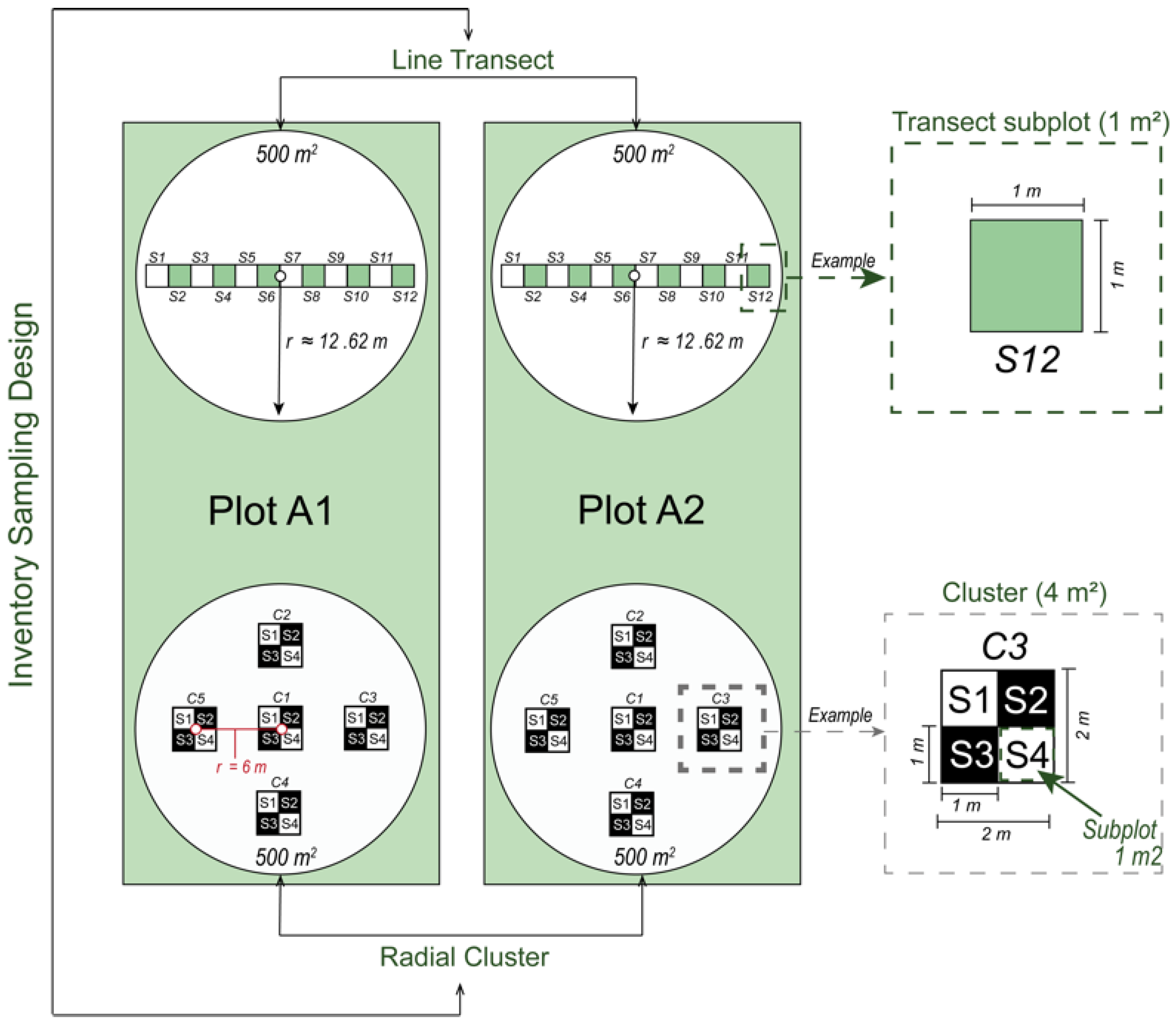
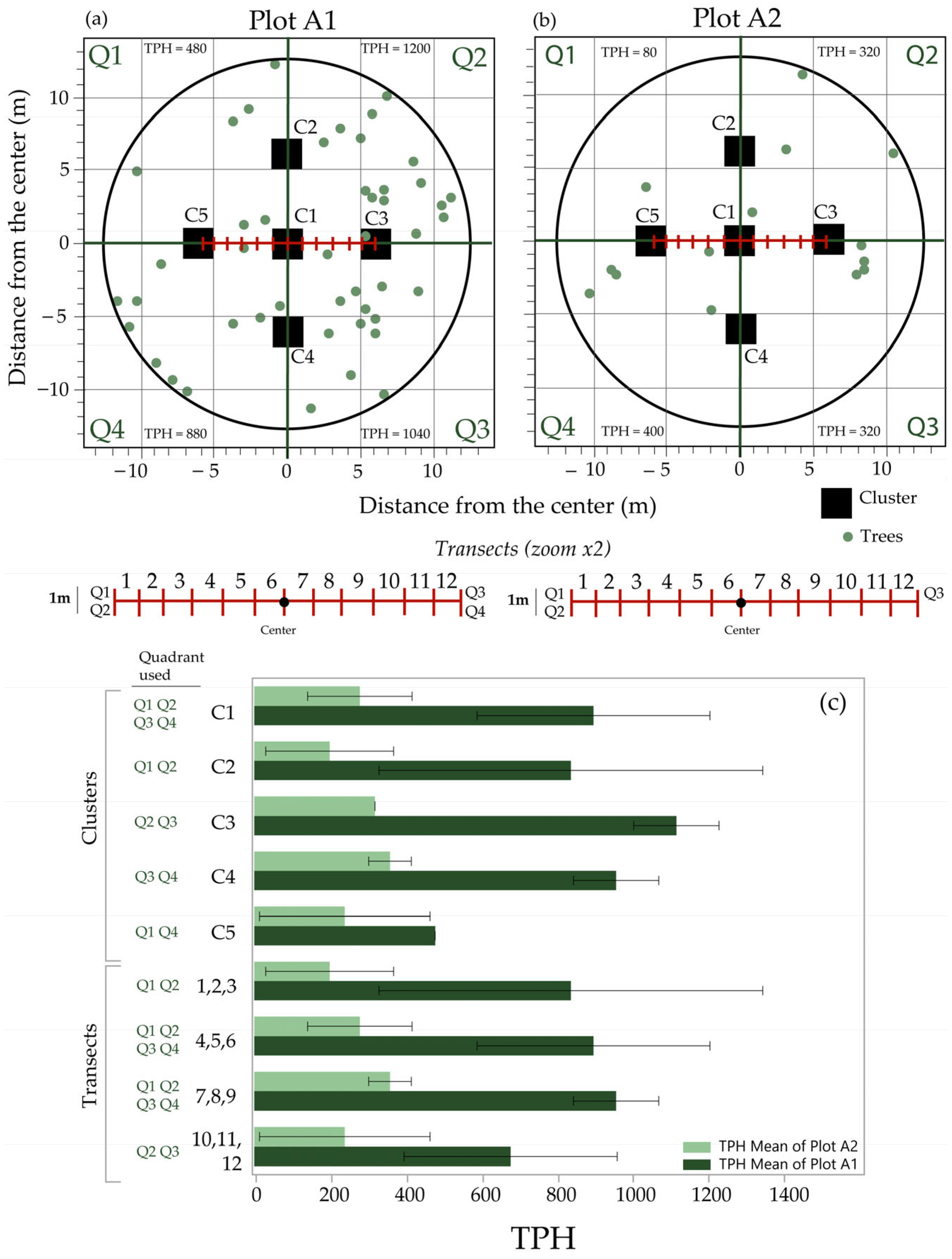
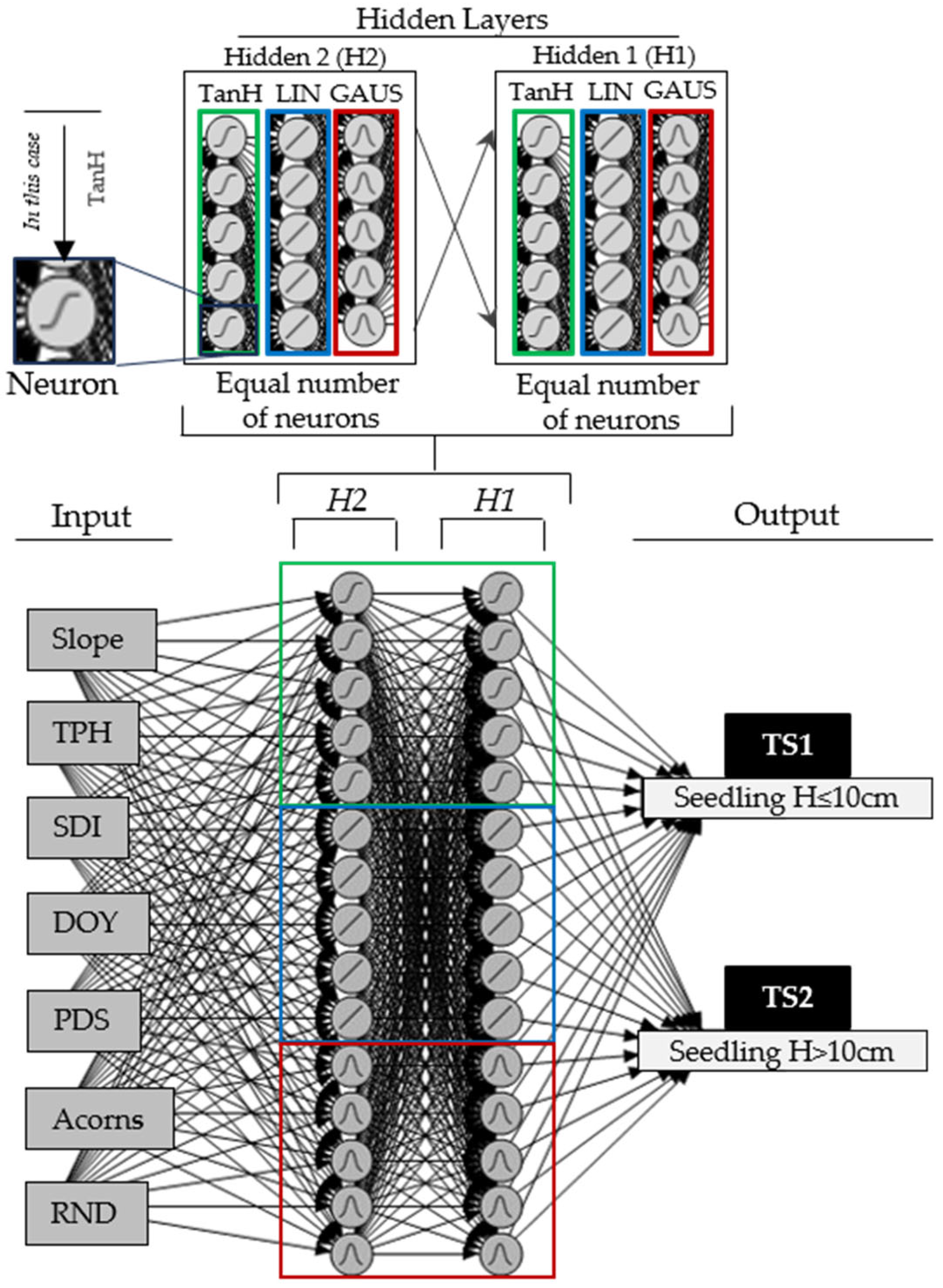
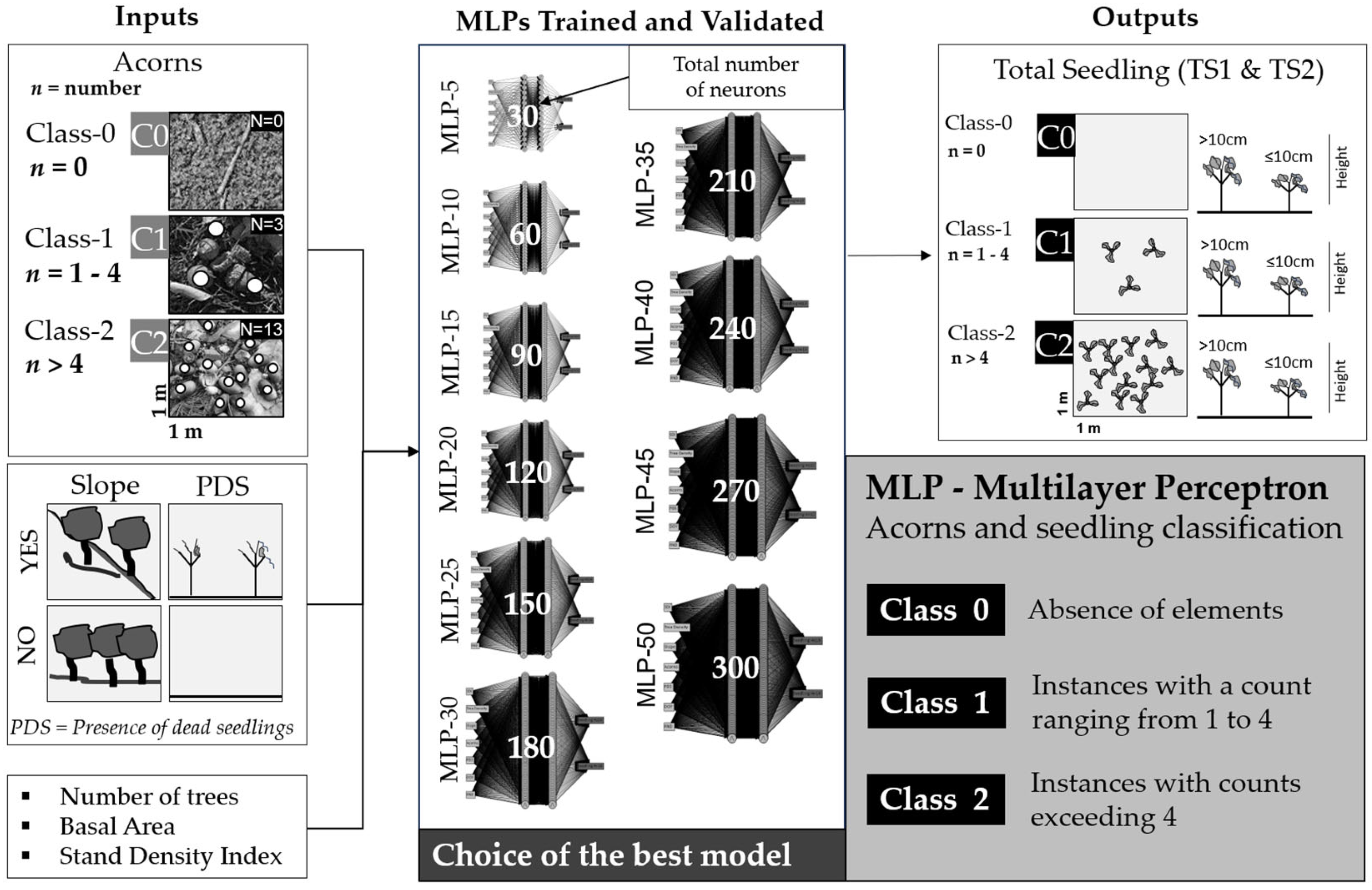
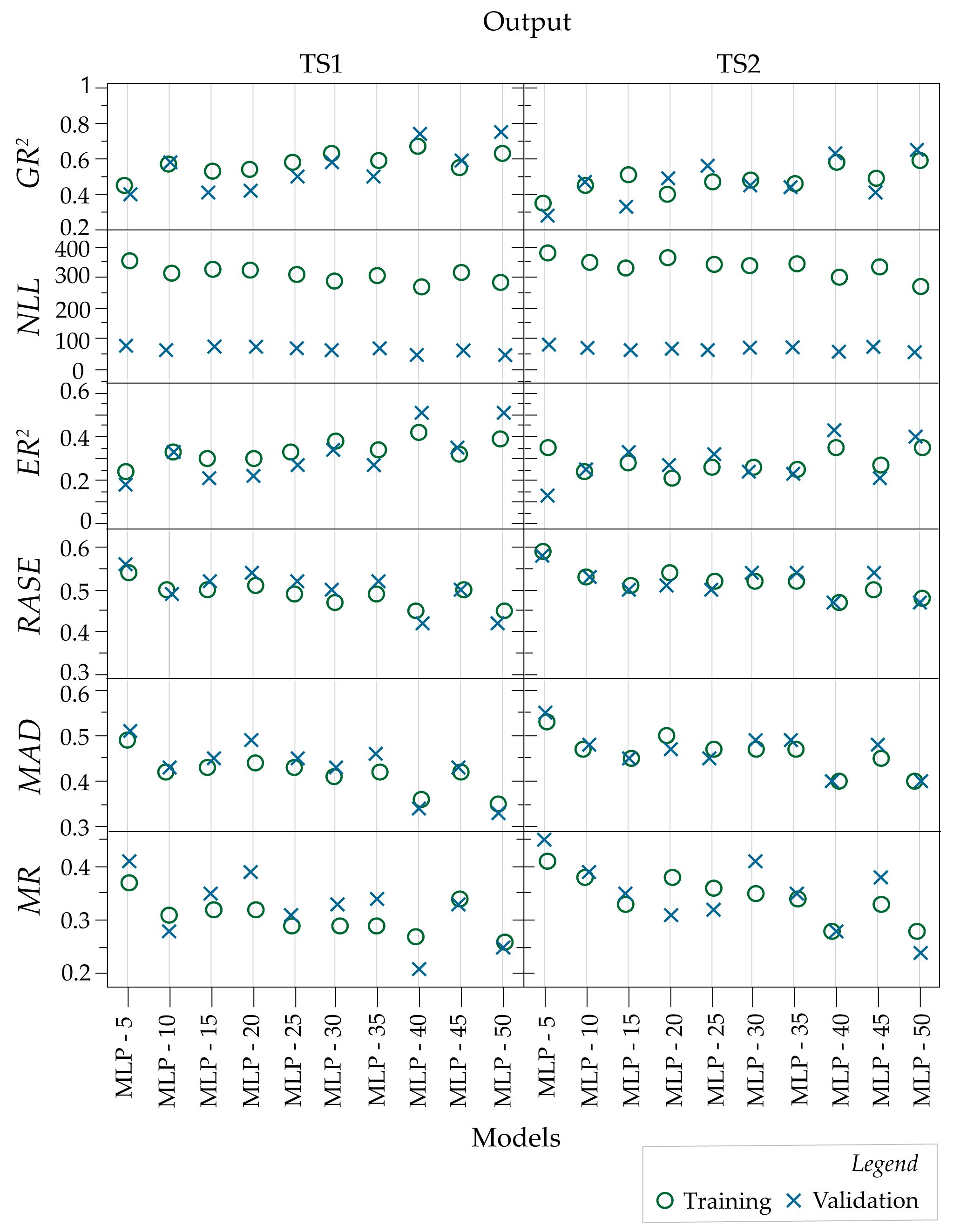
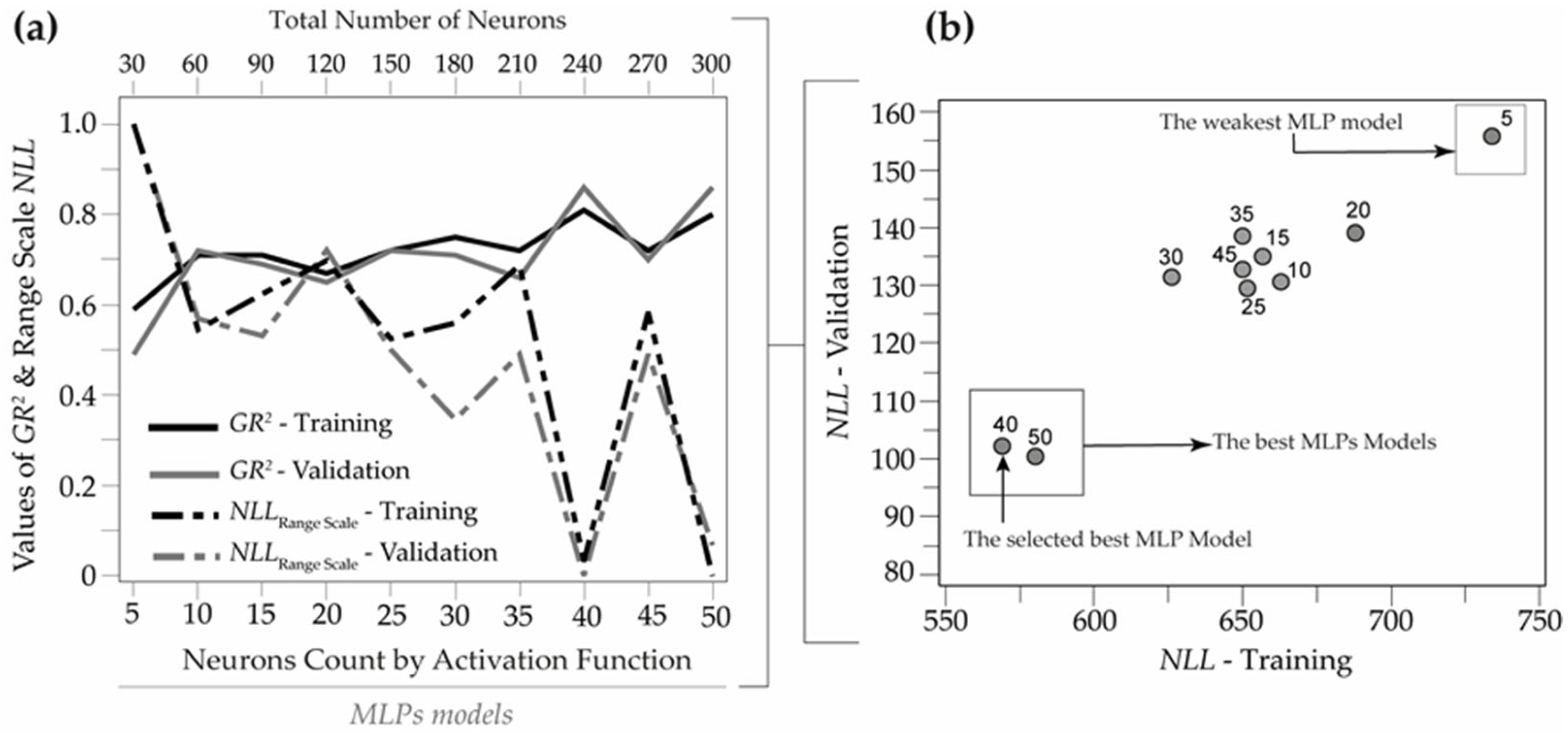
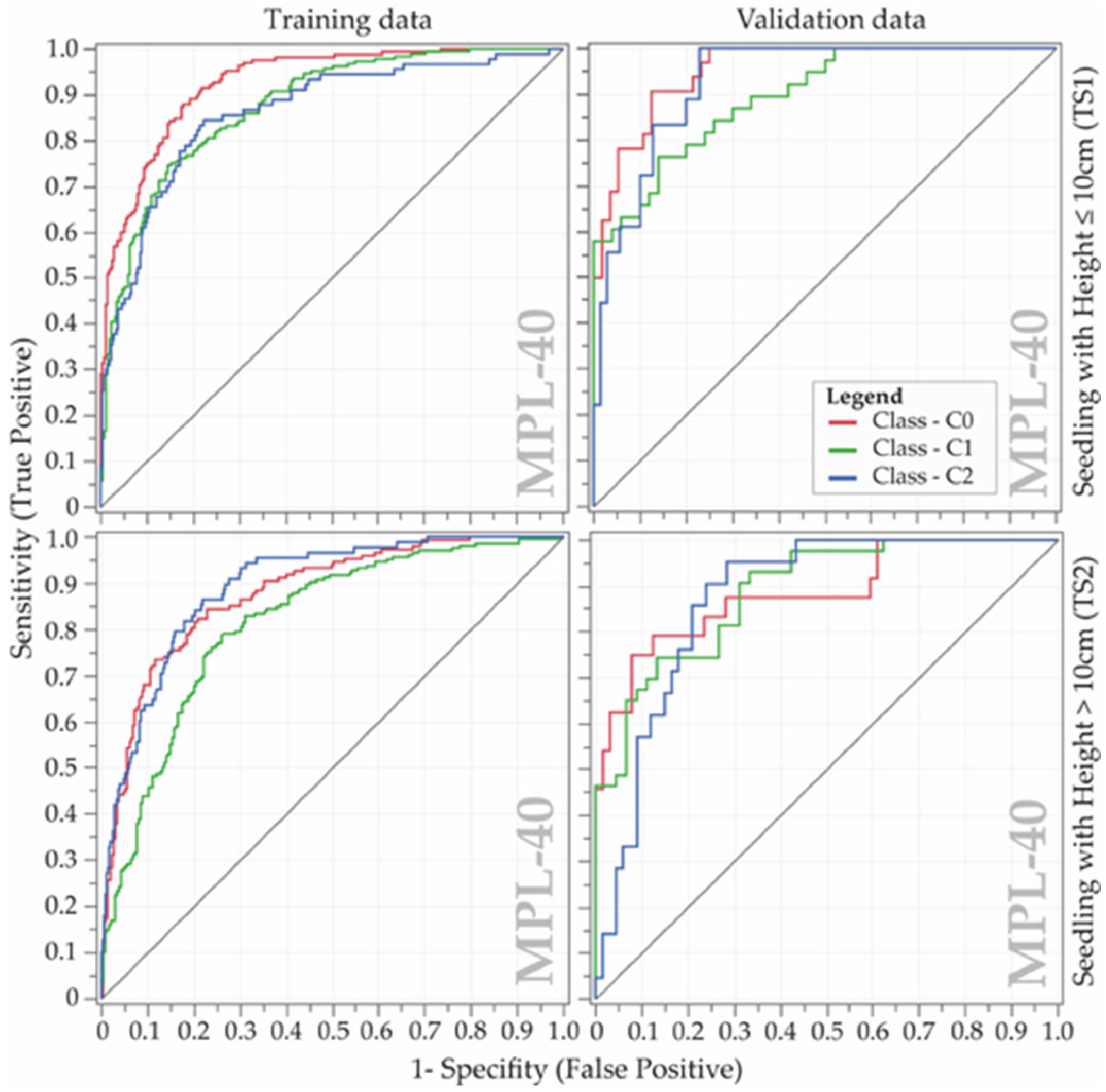
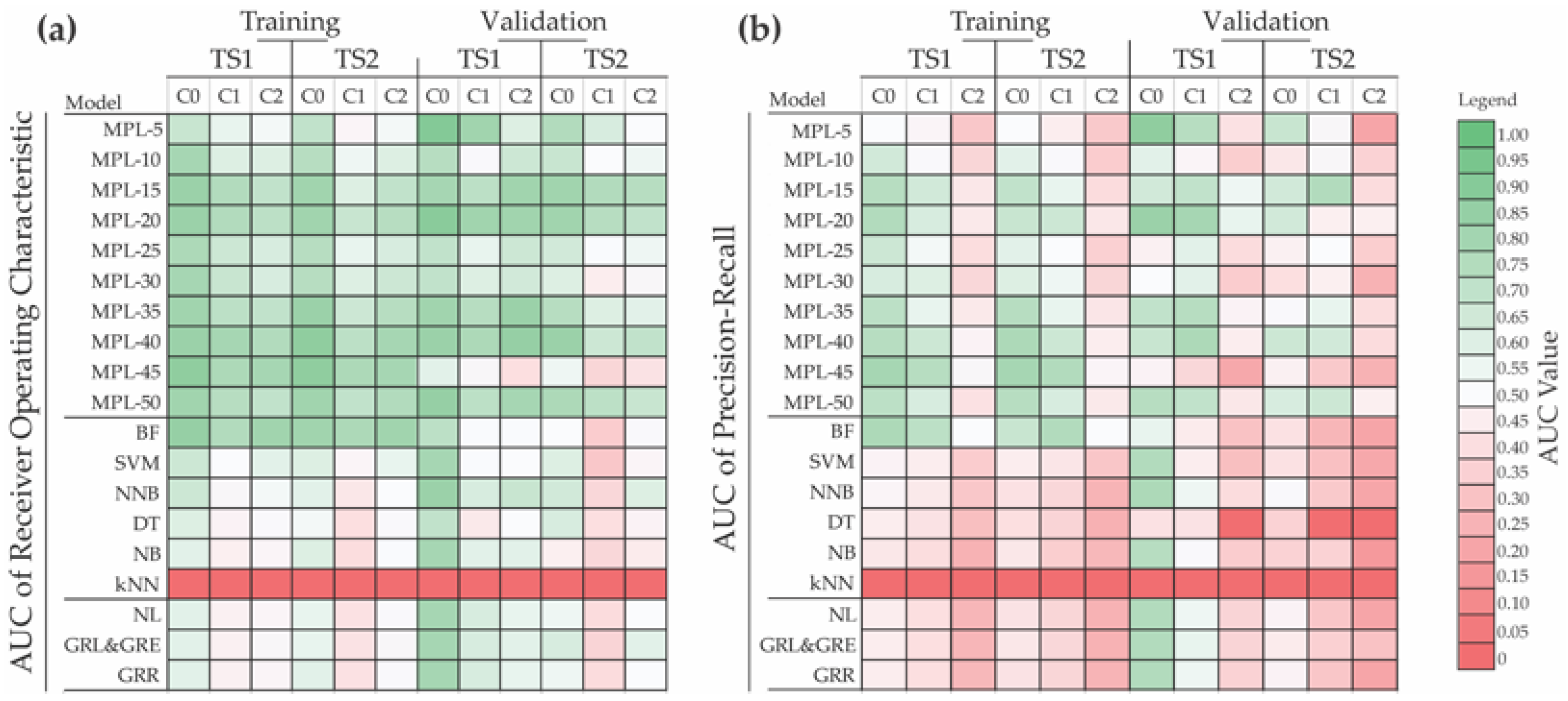
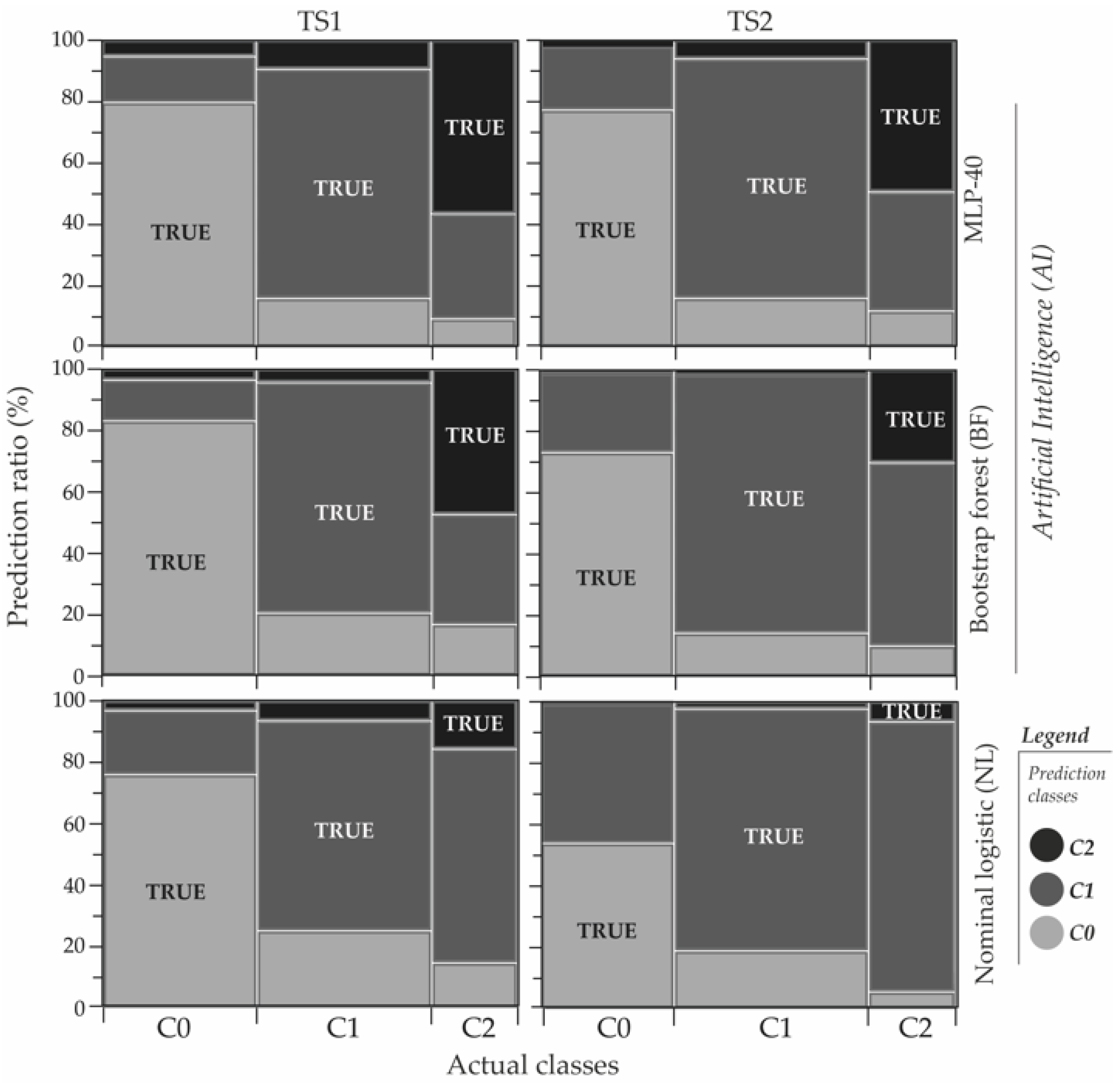
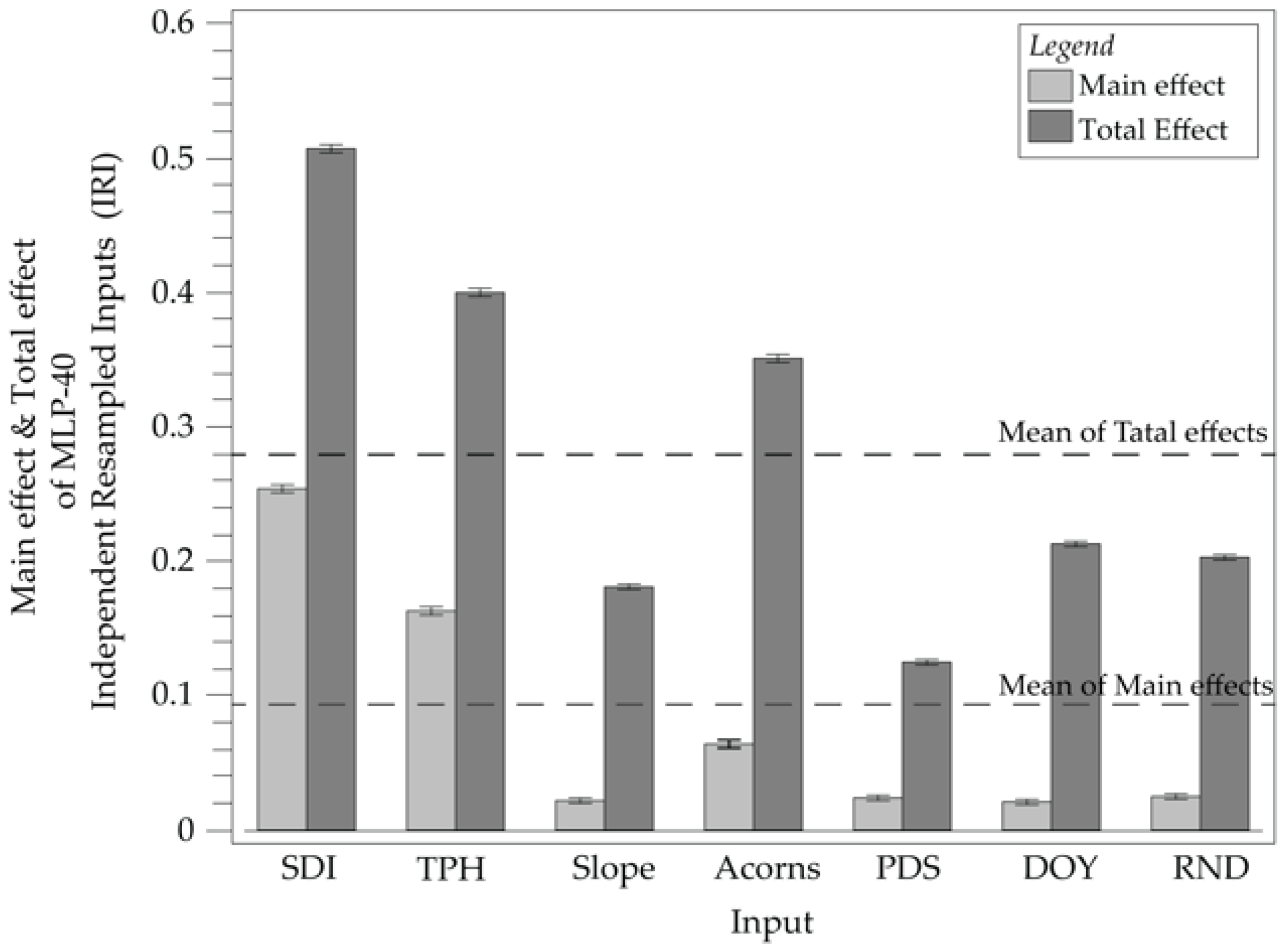
| Metric Parameter | Abbr. | Definition | Interpretation | Ref. |
|---|---|---|---|---|
| Generalized R2 | GR2 | Measures model performance; higher values close to 1 indicate better performance, while negative values imply worse performance compared with a model predicting the data’s average. | Higher GR2 values indicate superior model fit, while negative values reflect a poor performance. | [53] |
| Entropy R2 | ER2 | A variant of GR2 based on entropy theory; higher values close to 1 represent better performance. | Similar to GR2, higher values signify improved accuracy and model fit. | |
| Negative log-likelihood | NLL | Evaluates the likelihood of the model predictions given the data; lower NLL values denote a better fit. | Smaller NLL values reflect a superior model performance. | [54] |
| Root average squared error | RASE | Calculates the square root of the mean squared differences between the predictions and actual data values. | Smaller RASE values indicate a better predictive performance. | |
| Mean absolute deviation | MAD | Computes the average absolute difference between the predictions and actual data values. | Lower MAD values suggest a higher model accuracy. | [55,56] |
| Misclassification rate | MR | Proportion of misclassifications to total classifications; ranges from 0 (perfect classification) to 1 (all data misclassified). | Smaller MR values denote better a classification accuracy. | |
| Receiver operating characteristic (ROC) area under curve (AUC) | ROCAUC | The area under the receiver operating characteristic curve; it evaluates a binary classification model’s performance by plotting the true positive rate against the false positive rate at various thresholds. | AUC ranges from 0.5 (random classification) to 1 (perfect classification); higher values indicate better discrimination between classes. | [51,57] |
| Precision-recall (PR) area under curve | PRAUC | Evaluates the precision and recall for imbalanced datasets, focusing on positive class performance; ranges from 0 to 1. | A PRAUC value of 1 indicates perfect precision and recall, highlighting strong performance, particularly in imbalanced data scenarios. | [51,52,58] |
| Output | Actual | Predicted Rate | ||||||
|---|---|---|---|---|---|---|---|---|
| Training | Validation | |||||||
| C0 | C1 | C2 | C0 | C1 | C2 | |||
| MLP-40 model | TS1 | C0 | 0.82 | 0.13 | 0.04 | 0.94 | 0.03 | 0.03 |
| C1 | 0.17 | 0.77 | 0.07 | 0.16 | 0.79 | 0.05 | ||
| C2 | 0.14 | 0.38 | 0.48 | 0.17 | 0.33 | 0.50 | ||
| TS2 | C0 | 0.75 | 0.20 | 0.05 | 0.67 | 0.29 | 0.04 | |
| C1 | 0.15 | 0.78 | 0.07 | 0.07 | 0.86 | 0.07 | ||
| C2 | 0.11 | 0.38 | 0.51 | 0.24 | 0.29 | 0.48 | ||
| Output | Actual | Predicted Rate | ||||||
|---|---|---|---|---|---|---|---|---|
| Training | Validation | |||||||
| C0 | C1 | C2 | C0 | C1 | C2 | |||
| NNB model | TS1 | C0 | 0.80 | 0.20 | 0.01 | 0.82 | 0.16 | 0.02 |
| C1 | 0.28 | 0.69 | 0.03 | 0.20 | 0.78 | 0.03 | ||
| C2 | 0.18 | 0.71 | 0.11 | 0.25 | 0.70 | 0.05 | ||
| TS2 | C0 | 0.60 | 0.40 | 0.00 | 0.60 | 0.41 | 0.00 | |
| C1 | 0.26 | 0.75 | 0.00 | 0.34 | 0.66 | 0.00 | ||
| C2 | 0.09 | 0.91 | 0.00 | 0.11 | 0.90 | 0.00 | ||
| Response | Models | AICc | Δ (AICc) | BIC | Δ (BIC) |
|---|---|---|---|---|---|
| TS1 | NL | 790.36 | 0 | 869.06 | 0 |
| GRL | 808.91 | −18.55 | 880.07 | −11.01 | |
| GRE | 811.13 | −20.77 | 886.14 | −17.08 | |
| GRR | 813.72 | −23.36 | 892.58 | −23.52 | |
| TS2 | NL | 800.02 | 0 | 878.88 | −38.52 |
| GRL | 806.14 | −6.12 | 861.77 | −21.41 | |
| GRE | 820.26 | −20.24 | 840.36 | 0 | |
| GRR | 814.58 | −14.56 | 893.44 | −53.08 |
| Response | Source of Variation | χ2(Wald) | |||
|---|---|---|---|---|---|
| NL | GRL | GRE | GRR | ||
| TS1 | SDI | 0.00 ns | 28.62 *** | 21.51 *** | 9.35 ** |
| TPH | 0.00 ns | 77.45 *** | 71.01 *** | 57.58 *** | |
| Slope | 6.41 * | 6.39 ** | 6.39 * | 6.35 * | |
| Acorns | 78.37 ** | 73.2 *** | 73.19 *** | 73.03 *** | |
| PDS | 5.37 ns | 5.08 ns | 5.08 ns | 5.09 ns | |
| DOY | 0.84 ns | 0.82 ns | 0.82 ns | 0.85 ns | |
| RND | 0.22 ns | 0.21 ns | 0.21 ns | 0.22 ns | |
| TS2 | SDI | 0.00 ns | 57.95 *** | 57.80 *** | 12.59 ns |
| TPH | 0.00 ns | 6.78 * | 7.03 * | 57.50 *** | |
| Slope | 2.33 ns | 1.08 ns | 1.16 ns | 2.24 ns | |
| Acorns | 24.27 *** | 19.48 *** | 19.66 *** | 25.57 *** | |
| PDS | 2.99 ns | 1.84 ns | 1.95 ns | 3.33 ns | |
| DOY | 8.49 ** | 6.03 ** | 6.17 * | 8.15 * | |
| RND | 1.65 ns | 0.31 ns | 0.39 ns | 1.66 ns | |
| BF Model | Output | Input | Splits | G2 | Portion |
| TS1 | SDI | 51 | 12.77 | 0.05 | |
| TPH | 61 | 9.73 | 0.04 | ||
| Slope | 94 | 17.99 | 0.06 | ||
| Acorns | 84 | 71.94 | 0.26 | ||
| PDS | 40 | 8.41 | 0.03 | ||
| DOY | 349 | 53.13 | 0.19 | ||
| RND | 513 | 103.39 | 0.37 | ||
| TS2 | SDI | 8 | 19.62 | 0.07 | |
| TPH | 11 | 25.21 | 0.09 | ||
| Slope | 141 | 20.75 | 0.08 | ||
| Acorns | 132 | 33.46 | 0.13 | ||
| PDS | 43 | 8.94 | 0.03 | ||
| DOY | 302 | 53.60 | 0.2 | ||
| RND | 493 | 104.51 | 0.39 |
Disclaimer/Publisher’s Note: The statements, opinions and data contained in all publications are solely those of the individual author(s) and contributor(s) and not of MDPI and/or the editor(s). MDPI and/or the editor(s) disclaim responsibility for any injury to people or property resulting from any ideas, methods, instructions or products referred to in the content. |
© 2025 by the authors. Licensee MDPI, Basel, Switzerland. This article is an open access article distributed under the terms and conditions of the Creative Commons Attribution (CC BY) license (https://creativecommons.org/licenses/by/4.0/).
Share and Cite
Fierravanti, A.; Balducci, L.; Fonseca, T. Cork Oak Regeneration Prediction Through Multilayer Perceptron Architectures. Forests 2025, 16, 645. https://doi.org/10.3390/f16040645
Fierravanti A, Balducci L, Fonseca T. Cork Oak Regeneration Prediction Through Multilayer Perceptron Architectures. Forests. 2025; 16(4):645. https://doi.org/10.3390/f16040645
Chicago/Turabian StyleFierravanti, Angelo, Lorena Balducci, and Teresa Fonseca. 2025. "Cork Oak Regeneration Prediction Through Multilayer Perceptron Architectures" Forests 16, no. 4: 645. https://doi.org/10.3390/f16040645
APA StyleFierravanti, A., Balducci, L., & Fonseca, T. (2025). Cork Oak Regeneration Prediction Through Multilayer Perceptron Architectures. Forests, 16(4), 645. https://doi.org/10.3390/f16040645







